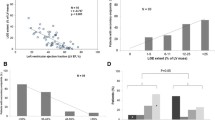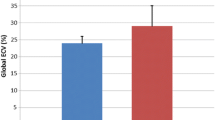Abstract
Dilated cardiomyopathy (DCM) is an inevitable complication of Duchenne muscular dystrophy (DMD). Late gadolinium enhancement (LGE) demonstrated by cardiac MRI occurs in DMD-related DCM, indicating myocyte death and remodeling. We conducted a retrospective chart review identifying DMD patients in our center between January 2009 and July 2013. Subjects were cohorted by presence of LGE before age 14. We excluded patients in whom we could not determine LGE status prior to age 14. We reviewed comprehensive clinical data. Of the 41 subjects with complete data, 15 demonstrated LGE before age 14 (“early LGE”) and 26 had no LGE by age 14 (“controls”). Those with early LGE exhibited a more rapid decline in LV fractional shortening (p = 0.028). Patients with early LGE were younger at age of initiation of ACE inhibition (p = 0.025), mineralocorticoid receptor antagonism (p = 0.0024), and beta-blockade (p = 0.0017), suggesting aggressive clinical management in response to abnormal MRI findings. There were no significant differences in LV dilation between the two groups (p = 0.1547). Early LGE was not associated with obesity (p = 0.32), age at loss of ambulation (p = 0.31), or heart rate (p-value > 0.8). Early onset of myocardial fibrosis as indicated by LGE on cardiac MRI is associated with earlier progression of cardiomyopathic changes despite earlier medication therapy. Identifying this risk factor, observed in 34% of our cohort during preadolescence, may guide medical therapy and early counseling about cardiomyopathy progression. We advocate for obtaining at least one MRI in patients with DMD prior to age 14 to risk stratify patients.






Similar content being viewed by others
References
Goodwin FC, Muntoni F (2005) Cardiac involvement in muscular dystrophies: molecular mechanisms. Muscle Nerve 32:577–588. https://doi.org/10.1002/mus.20352
Emery AE, Skinner R, Howden LC, Matthews MB (1982) Verapamil in Duchenne muscular dystrophy. Lancet 1:559. https://doi.org/10.1016/s0140-6736(82)92063-3
Su JA, Ramos-Platt L, Menteer J (2016) Left ventricular tonic contraction as a novel biomarker of cardiomyopathy in Duchenne muscular dystrophy. Pediatr Cardiol 37:678–685. https://doi.org/10.1007/s00246-015-1331-1
Silva MC, Meira ZM, Gurgel Giannetti J, da Silva MM, Campos AF, MeM B, Starling Filho GM, ReA F, Zatz M, Rochitte CE (2007) Myocardial delayed enhancement by magnetic resonance imaging in patients with muscular dystrophy. J Am Coll Cardiol 49:1874–1879. https://doi.org/10.1016/j.jacc.2006.10.078
Hor KN, Taylor MD, Al-Khalidi HR, Cripe LH, Raman SV, Jefferies JL, O’Donnell R, Benson DW, Mazur W (2013) Prevalence and distribution of late gadolinium enhancement in a large population of patients with Duchenne muscular dystrophy: effect of age and left ventricular systolic function. J Cardiovasc Magn Reson 15:107. https://doi.org/10.1186/1532-429X-15-107
Emery AE (2002) The muscular dystrophies. Lancet 359:687–695. https://doi.org/10.1016/S0140-6736(02)07815-7
Nigro G, Comi LI, Politano L, Bain RJ (1990) The incidence and evolution of cardiomyopathy in Duchenne muscular dystrophy. Int J Cardiol 26:271–277. https://doi.org/10.1016/0167-5273(90)90082-g
Florian A, Ludwig A, Engelen M, Waltenberger J, Rösch S, Sechtem U, Yilmaz A (2014) Left ventricular systolic function and the pattern of late-gadolinium-enhancement independently and additively predict adverse cardiac events in muscular dystrophy patients. J Cardiovasc Magn Reson 16:81. https://doi.org/10.1186/s12968-014-0081-1
Tandon A, Villa CR, Hor KN, Jefferies JL, Gao Z, Towbin JA, Wong BL, Mazur W, Fleck RJ, Sticka JJ, Benson DW, Taylor MD (2015) Myocardial fibrosis burden predicts left ventricular ejection fraction and is associated with age and steroid treatment duration in duchenne muscular dystrophy. J Am Heart Assoc. https://doi.org/10.1161/JAHA.114.001338
Raman SV, Hor KN, Mazur W, Halnon NJ, Kissel JT, He X, Tran T, Smart S, McCarthy B, Taylor MD (2015) Eplerenone for early cardiomyopathy in Duchenne muscular dystrophy: a randomised, double-blind, placebo-controlled trial. The Lancet Neurology. 14:153–161. https://doi.org/10.1016/S1474-4422(14)70318-7
Dittrich S, Graf E, Trollmann R, Neudorf U, Schara U, Heilmann A, von der Hagen M, Stiller B, Kirschner J, Dalla Pozza R (2019) Effect and safety of treatment with ACE-inhibitor Enalapril and β-blocker metoprolol on the onset of left ventricular dysfunction in Duchenne muscular dystrophy-a randomized, double-blind, placebo-controlled trial. Orphanet J Rare Dis 14:105. https://doi.org/10.1186/s13023-019-1066-9
Bish LT, Yarchoan M, Sleeper MM, Gazzara JA, Morine KJ, Acosta P, Barton ER, Sweeney HL (2011) Chronic losartan administration reduces mortality and preserves cardiac but not skeletal muscle function in dystrophic mice. PLoS ONE 6:e20856. https://doi.org/10.1371/journal.pone.0020856
Viollet L, Thrush PT, Flanigan KM, Mendell JR, Allen HD (2012) Effects of angiotensin-converting enzyme inhibitors and/or beta blockers on the cardiomyopathy in Duchenne muscular dystrophy. Am J Cardiol 110:98–102. https://doi.org/10.1016/j.amjcard.2012.02.064
Judge DP, Kass DA, Thompson WR, Wagner KR (2011) Pathophysiology and therapy of cardiac dysfunction in Duchenne muscular dystrophy. Am J Cardiovascular Drugs. 11:287–294. https://doi.org/10.2165/11594070-000000000-00000
Yancy CW, Jessup M, Bozkurt B, Butler J, Casey DE, Drazner MH, Fonarow GC, Geraci SA, Horwich T, Januzzi JL (2013) 2013 ACCF/AHA guideline for the management of heart failure: a report of the American college of cardiology Foundation/American heart association task force on practice guidelines. J Am College Cardiol 62:e147–e239. https://doi.org/10.1016/j.jacc.2013.05.019
Adorisio R, Mencarelli E, Cantarutti N, Calvieri C, Amato L, Cicenia M, Silvetti M, D’Amico A, Grandinetti M, Drago F (2020) Duchenne dilated cardiomyopathy: cardiac management from prevention to advanced cardiovascular therapies. J Clinical Med 9:3186. https://doi.org/10.3390/jcm9103186
Thomas TO, Morgan TM, Burnette WB, Markham LW (2012) Correlation of heart rate and cardiac dysfunction in Duchenne muscular dystrophy. Pediatric Cardiol 33:1175–1179. https://doi.org/10.1007/s00246-012-0281-0
McKane M, Soslow JH, Xu M, Saville BR, Slaughter JC, Burnette WB, Markham LW (2017) Does body mass index predict premature cardiomyopathy onset for Duchenne muscular dystrophy? J Child Neurol 32:499–504. https://doi.org/10.1177/0883073816687422
Lalić T, Guć-Sćekić M, Djurisić M, Radivojević D, Zamurović D, Todorović S (2001) Deletions in the dystrophin gene and its phenotype expression. Srp Arh Celok Lek 129:3–5
Muntoni F, Gobbi P, Sewry C, Sherratt T, Taylor J, Sandhu SK, Abbs S, Roberts R, Hodgson SV, Bobrow M (1994) Deletions in the 5’region of dystrophin and resulting phenotypes. J Med Genetics. 31:843–847. https://doi.org/10.1136/jmg.31.11.843
Love DR, Flint TJ, Marsden RF, Bloomfield JF, Daniels RJ, Forrest SM, Gabrielli O, Giorgi P, Novelli G, Davies KE (1990) Characterization of deletions in the dystrophin gene giving mild phenotypes. Am J Med Genetics. 37:136–142. https://doi.org/10.1002/ajmg.1320370132
Muntoni F, Torelli S, Ferlini A (2003) Dystrophin and mutations: one gene, several proteins, multiple phenotypes. The Lancet Neurol 2:731–740. https://doi.org/10.1016/s1474-4422(03)00585-4
Ferlini A, Sewry C, Melis MA, Mateddu A, Muntoni F (1999) X-linked dilated cardiomyopathy and the dystrophin gene. Neuromuscul Disord 9:339–346. https://doi.org/10.1016/s0960-8966(99)00015-2
Flanigan, K. M., Ceco, E., Lamar, K. M., Kaminoh, Y., Dunn, D. M., Mendell, J. R., & United Dystrophinopathy Project (2013) LTBP4 genotype predicts age of ambulatory loss in Duchenne muscular dystrophy. Ann Neurol 73(4):481–488
Bello, L., Kesari, A., Gordish-Dressman, H., Cnaan, A., Morgenroth, L. P., Punetha, J., & Cooperative International Neuromuscular Research Group Investigators (2015) Genetic modifiers of ambulation in the cooperative international Neuromuscular research group Duchenne natural history study. Ann Neurol 77(4):684–696
Funding
The authors have no relevant financial or non-financial interests to disclose. Partial funding for statistics was obtained through the Division of Cardiology and the Pediatric Residency Program at Children’s Hospital Los Angeles.
Author information
Authors and Affiliations
Contributions
Dr. James collected the data, contributed to study design, carried out the initial analyses, drafted the initial manuscript, and reviewed and revised the manuscript. Dr. Menteer reviewed initial analysis, contributed to study design, and reviewed and significantly revised the manuscript. Drs. Lilith Moss and Durazo-Arvizu performed statistical analysis, wrote the section on statistics methodology, composed the figures and table design, and reviewed and revised the manuscript. Dr. Wood reviewed initial analysis, contributed to study design, wrote the section on imaging methodology, and reviewed and revised the manuscript. Drs. Ramos-Platt and Tiongson compiled genetic data and reviewed and revised the manuscript. Dr. Su conceptualized and designed the study, supervised data collection, reviewed initial analyses, coordinated statistical resources, and reviewed and significantly revised the manuscript.
Corresponding author
Ethics declarations
Conflict of interest
The authors have no conflict of interest to disclose.
Informed consent
The Institutional Review Board at Children’s Hospital Los Angeles approved this study and waived the need for informed consent.
Ethical approval
All authors approved the final manuscript as submitted and agreed to be accountable for all aspects of the work.
Additional information
Publisher's Note
Springer Nature remains neutral with regard to jurisdictional claims in published maps and institutional affiliations.
Rights and permissions
Springer Nature or its licensor holds exclusive rights to this article under a publishing agreement with the author(s) or other rightsholder(s); author self-archiving of the accepted manuscript version of this article is solely governed by the terms of such publishing agreement and applicable law.
About this article
Cite this article
James, L., Menteer, J., Moss, L.C. et al. Early-Onset Late Gadolinium Enhancement is a Prognostic Factor for Duchenne Cardiomyopathy. Pediatr Cardiol 44, 433–440 (2023). https://doi.org/10.1007/s00246-022-02989-8
Received:
Accepted:
Published:
Issue Date:
DOI: https://doi.org/10.1007/s00246-022-02989-8




